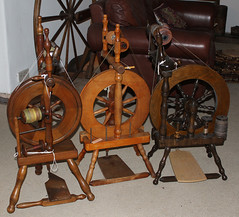I could ask you to guess what is pictured below:

For most people this is an unsual sight and unexpected, probably not a fair question.
This is the underside of my Ashford Traveller spinning wheel.
Ever since I got this wheel I was trying to track down and eliminate odd creaks and groans from the wheel. I tightened and replace many screws. In spite of my efforts it was getting more creaky, and becoming very hard to treadle, especially I discovered on un-carpeted floors - a clue here. With a bit of investigation I discovered that every time I pressed the treadle one of the legs moved sideways. I found the leg is fitted in with a screw, and unlike the other three legs it was loose. When I undid the screw I could easily take it out, but I could not get it to fit back in without wobbling as the hole it fitted into was oversized. What you see in the photo is a shim of old Christmas card taking up the spare space. It does the job, no more wobbly leg.
However, there was still a groaning from the treadle. I found that every single screw in the treadle needed an extra half turn. Having sorted this out, I oiled everything and went back to spinning - wow! it's like a different wheel. Tip for anyone with a grumbling & groaning wheel: check all the joints, tighten all the screws, oil all the moving parts.

So, what have I been up to with this spinning wheel? Spinning a weft yarn to weave another scarf on my table loom. After I finished the handspun, handwoven scarf at Christmas I was filled with the joy of weaving and thought "another!". I pulled a pretty multicoloured Noro yarn out of a stash box for weft, prepared the warp, warped the loom, but then I was stuck. I just couldn't find a weft to match it. I tried cotton, I tried wools in different colours, I tried bright colour and I tried neutrals.
It dawned on me that the weeks I spent thinking about colours and weave pattern for the handspun & handwoven scarf I'd just finished were not just idle thinking but very important creative planning and design time.
I stopped to think.
One thought I had was that I have many different fibres to spin and I have dyes and I can create the yarn I want. I looked at some different colours and found I had Shetland wool fibre dyed that I had dyed with madder last summer and the orange-red colour was just what I needed for this warp.
So, weaving had to wait while I spun a new weft yarn.

I had spun all the madder-dyed wool I had, but didn't even have one full bobbin. I know a bobbin holds about 100g of yarn which is the amount I have used in the past for weft in a scarf like this.

Spinning had to wait while I dyed more wool.

I managed a reasonably close match, one ball is slightly more red, the other slightly more orange so I'm weaving alternately with the two yarns in two shuttles.

The pattern I've chosen is my favourite 4-shaft undulating twill, as you can see in the header row bellow. I wove the header in high-contast thick white yarn so I can see what is happening in the warp easily. As the straight edge shows, I needed to adjust the tension on some of the warp. Towards the right of the photo you'll see the white weft yarn doesn't quite reach the straight edge, although it does on either side. Looking at this I know that means I have some tighter weft threads in that area. The weft yarn packs up closer in tight sections so the edge of the weaving dips towards the weaver, whilst in a loose section the warp threads would bulge away.

It's good to be fussy and slow when you start a piece of weaving and correct little errors like this, I have learnt that leaving anything I'm not entirely happy with at this stage is likely to mean that later on the problem has become magnified and I am unhappy with the cloth. When I was a new weaver I rushed the loom set up, but after various different disappointments I learnt that being relaxed about preparing the loom and fussing over little things would save heartache later.

I'm delighted with the colour of my madder weft. Maybe I've spun it a little thick, but we'll have to see how it is when it comes off the loom.
Just to finish up, these are some of the wefts I tried that didn't work! The first was a green knitting cotton, as I like green and orange and though the shiny cotton yarn might be a good contrast with the Noro wool. It was not good.

I also tried neutrals, a grey and a soft brown.

I much prefer the madder-dyed yarn!







































